Teams and drivers
The following drivers and teams competed in the 1989 Australian Touring Car Championship.
The 1989 Australian Touring Car Championship was a CAMS sanctioned Australian motor racing title open to Group 3A Touring Cars. [1] The championship, which was the 30th Australian Touring Car Championship, [2] began on 5 March at Amaroo Park and ended on 9 July at Oran Park Raceway after eight rounds. [3] The 1989 Australian Manufacturers' Championship was contested over the same eight round series.
The championship, which was promoted as the Shell Ultra Australian Touring Car Championship, [4] was won by Dick Johnson driving a Ford Sierra RS500. [2] Toyota won the Australian Manufacturers' Championship. [2]
The following drivers and teams competed in the 1989 Australian Touring Car Championship.
Following on from their dominant 1988 championship 1-2, the Dick Johnson Racing Ford Sierra RS500 drivers Dick Johnson and John Bowe again finished 1-2 in the title race, winning the first six rounds with Johnson's fifth (and last) championship win equaling the record of Ian Geoghegan. Like Geoghegan, all of Dick Johnson's championships were won driving Fords.
The championship also saw long time Holden driver Peter Brock turn to Fords (after a year with BMW) in a bid to return to the top in Australia with two cars secured from British Sierra expert Andy Rouse for himself and Albury based driver Brad Jones. Brock's pole in Round 2 at Symmons Plains was his first touring car pole since the 1986 Sandown 500, while his win in the final round at Oran Park was his first ATCC win since 1986 and his first ever ATCC win in anything other than a Holden. Brock in his Mobil 1 Racing Sierra would prove to be the Shell team's most consistent challenger, finishing third in the championship, his highest placing since he finished third in 1985. Most observers felt that Brock adapted to the powerful Sierra's quicker than most, though he readily admitted his link with Rouse and the technical help he gave was a big factor in the Mobil teams revival. Also, unlike most of his fellow competitors when they started racing the Sierra's, Brock wasn't a stranger to racing turbocharged cars having raced a Porsche 956B at Silverstone and Le Mans in the 1984 World Sportscar Championship.
Other driver/team changes in 1989 included a new Ford Sierra team for former Nissan driver Glenn Seton who took Nissan's Peter Jackson cigarette sponsorship with him to his new team. Also switching from Nissan was his father Barry Seton who became the chief engine builder for his sons new team. 1988 Tooheys 1000 winner Tony Longhurst expanded his Benson & Hedges Racing to a two car team with a second Sierra for former JPS Team BMW teammate Neville Crichton. The two B&H cars had been acquired from the Wolf Racing Australasia team formerly run by Robbie Francevic and his long-time patron Mark Petch. Colin Bond also expanded his Caltex-backed Sierra team to two cars, running a second for Sydney car dealer Ken Mathews who had purchased the Bathurst winning Sierra from Longhurst. For the first time in Australian Group A, BMW wasn't represented by one of the top teams which prompted BMW Australia to pull out. The M3 was reduced to a class runner and it was left to privateers John Cotter and his regular co-driver Peter Doulman running one of the ex-JPS/Mobil M3's purchased from Brock at the end of 1988 to keep a BMW presence on the grid.
1989 also saw the last ATCC round win for long time factory Nissan driver George Fury when he took victory in Round 7 at the tight Winton circuit in rural Victoria in what proved to be the most competitive race of the championship. In fact, when Peter Brock led at the end of lap one at Winton it was actually the first time since Round 6 in 1988 at Lakeside that someone other than Dick Johnson or John Bowe had led the first lap of an ATCC race (on that occasion it was the Sierra of Andrew Miedecke leading as Johnson had been pinged for a jump start, though Johnson led on the road). Fury, who had been with the team since its inaugural year in 1981, was joined in the Nissan team by 1985 and 1987 champion Jim Richards, and the teams 1987 Australian 2.0 Litre champion Mark Skaife, each driving a turbocharged Skyline HR31 GTS-R. The Skyline, which had been late arriving in 1988 and had run short of development, was more of a force in 1989 with the team finding greater power and reliability from the turbocharged 6 cyl 2.0L twin cam engine as well as getting the cars down to the Nissan's weight limit of 1100 kg, some 70 kg lighter than 1988. Skaife made his first appearance of the series at the Mallala circuit in South Australia for Round 5, and avoided the first corner carnage (caused by an out of control Brock) to finish a fine fifth.
The 1989 championship was the first since 1970 to be contested without an appearance by a factory supported Holden team. The Holden Special Vehicles team did not compete in the series, despite entering two Commodores for highly respected British driver Win Percy and Channel 7 commentator Neil Crompton in the opening round at Amaroo Park (a fact that Crompton's co-commentators Mike Raymond and Gary Wilkinson constantly reminded him about during the race telecasts). Allan Grice was the highest placed Holden driver in the championship, finishing in a hard-fought fourth position after a one-off appearance at Winton in a privately entered Roadways Racing Commodore he had driven in the 1988 Tooheys 1000. The Winton round, which started on a wet track and was damp throughout with a couple of additional showers, saw Grice ran the race on one set of wet tyres. The highest placed Holden driver from 1987 and 1988 championship, Larry Perkins, appeared in only two rounds (Sandown and Winton) with his privately entered Commodore, the same car he had driven at Bathurst the previous year as part of the factory backed Holden Special Vehicles/TWR team. 1989 was thus the first year in which no Holden driver had finished the championship inside the top ten positions since Herb Taylor placed twelfth in a Holden EH in 1968, the last year in which the ATCC was contested as a single race. Holden's lack of interest in the 1989 ATCC was not well received either by the fans or television broadcaster Channel 7. It was Holden's lack of representation from the factory backed team or the privateers that highlighted the growing costs of Group A racing, something which would cause a change in the sport after 1992.
Venue changes from the 1988 Championship were the deletion of the round at Calder Park and the addition of a round at the 2.601 km (1.616 mi) Mallala Motor Sport Park, located 55 km north of Adelaide. Mallala returned to the championship for the first time since 1971, replacing the round at the Bob Jane owned Adelaide International Raceway. Calder owner Bob Jane had signed an agreement with "Vic Health" which saw cigarette advertising banned at his race tracks (cigarette sponsorship was prominent in the ATCC with the Seton and Longhurst teams sponsored by Peter Jackson and Benson & Hedges respectively). As Jane also owned the Adelaide circuit, this saw AIR also dropped from the calendar.
Round 3 of the championship at Lakeside just north of Brisbane was full of drama. Initially scheduled to be run on 2 April, the meeting was postponed two weeks due to almost a weeks worth of heavy rain in the area which flooded the nearby Lake Kurwongbah that gives the circuit its name. The flooding saw both the front straight and pit area under about a foot of water. The race then took place on 16 April but was marred by a fiery crash on the back straight when Andrew Miedecke's Sierra collided with the VL Commodore of Graham Lusty while Lusty was being lapped. Both cars crashed heavily into the fence, as did the Sierra of the closely following Glenn Seton (Racecam from Brock's car caught the moment out of his rear window when the pair touched). Both the Commodore and Miedecke Sierra were engulfed in flames and wisely the race was red flagged. After a delay while the clean up was on, the race was reduced from 60 to 30 minutes with half points to be awarded for the round. Dick Johnson went on to win on his home circuit for the first time since his epic battle with Brock which won him his first ATCC back in 1981.
1989 would prove to be the last ATCC contested by four-time champion Allan Moffat with the Canadian born driver retiring from driving at the end of the year.
The 1989 Australian Touring Car Championship was contested over eight rounds, [3] with each round being a single race over a duration of approximately one hour. [1]
| Rd. | Circuit | Location / state | Date | Winning driver | Winning car | Winning team | Report |
|---|---|---|---|---|---|---|---|
| 1 | Amaroo Park | Sydney, New South Wales | 5 March | | Ford Sierra RS500 | Shell Ultra Hi Racing | [5] |
| 2 | Symmons Plains Raceway | Launceston, Tasmania | 12 March | | Ford Sierra RS500 | Shell Ultra Hi Racing | [6] |
| 3 | Lakeside International Raceway | Brisbane, Queensland | 16 April | | Ford Sierra RS500 | Shell Ultra Hi Racing | [7] |
| 4 | Barbagallo Raceway | Perth, Western Australia | 30 April | | Ford Sierra RS500 | Shell Ultra Hi Racing | [8] |
| 5 | Mallala Motor Sport Park | Mallala, South Australia | 7 May | | Ford Sierra RS500 | Shell Ultra Hi Racing | [9] |
| 6 | Sandown Raceway | Melbourne, Victoria | 21 May | | Ford Sierra RS500 | Shell Ultra Hi Racing | [10] |
| 7 | Winton Motor Raceway | Benalla, Victoria | 4 June | | Nissan Skyline HR31 GTS-R | Nissan Motorsport Australia | [11] |
| 8 | Oran Park Raceway | Sydney, New South Wales | 9 July | | Ford Sierra RS500 | Mobil 1 Racing | [12] |
Points were awarded on a 20–15–12–10–8–6–4–3–2–1 basis for the top ten race positions. [13] Only half points were awarded for Round 3 at Lakeside [13] due to the stoppage of the initial race and the reduced 30-minute duration of the restarted race. The pointscore system allowed a driver to retain points only from his or her seven best round results. [13] Discarded placings are shown within brackets in the table below.
|
The 1989 Australian Manufacturers' Championship, which was contested concurrently with the 1989 Australian Touring Car Championship, was won by Toyota. [14]
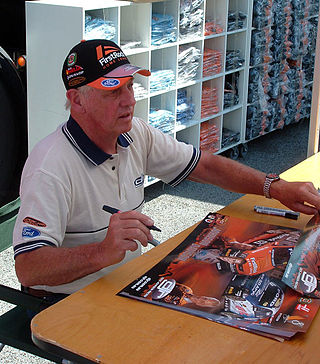
Richard 'Dick' Johnson is a part-owner of the V8 Supercar team Dick Johnson Racing and a former racing driver. As a driver, he was a five-time Australian Touring Car Champion and a three-time winner of the Bathurst 1000. As of 2008 Johnson has claimed over twenty awards and honours, including the V8 Supercars Hall of Fame into which he was inducted in 2001.
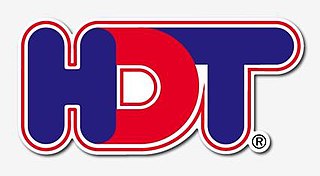
The Holden Dealer Team (HDT) was Holden's semi-official racing team from 1969 until 1986, primarily contesting Australian Touring Car events but also rallying, rallycross and Sports Sedan races during the 1970s. From 1980 the Holden Dealer Team, by then under the ownership of Peter Brock, diversified into producing modified road-going Commodores and other Holden cars for selected dealers via HDT Special Vehicles.
Allan George MoffatOBE is a Canadian-Australian racing driver known for his four championships in the Australian Touring Car Championship, six wins in the Sandown 500 and his four wins in the Bathurst 500/1000. Moffat was inducted into the V8 Supercars Hall of Fame in 1999.

Neil Crompton is a well-known Supercars presenter and commentator.
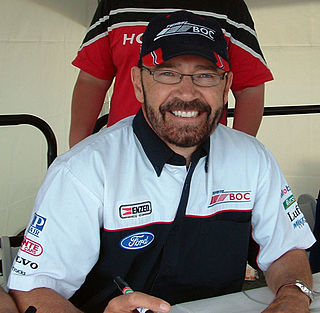
John Bowe is an Australian racing driver, presently racing a Holden Torana in the Touring Car Masters series.

The 1994 Australian Touring Car Championship was an Australian motor racing competition for Touring Cars. The championship, which was sanctioned by the Confederation of Australian Motor Sport as an Australian Title, was the 35th Australian Touring Car Championship. Promoted as the Shell Australian Touring Car Championship, it was contested over 10 rounds between February and July 1994.
The 1990 Australian Touring Car Championship was a CAMS sanctioned Australian motor racing title open to Group 3A Touring Cars. The championship, which was the 31st Australian Touring Car Championship, was promoted as the Shell Ultra Australian Touring Car Championship. It began on 25 February 1990 at Amaroo Park and ended on 15 July at Oran Park Raceway after eight rounds.
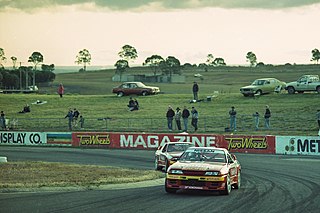
The 1992 Australian Touring Car Championship was the 33rd running of the Australian Touring Car Championship. It was a CAMS sanctioned motor racing title for drivers of Group 3A Touring Cars, commonly known as Group A cars. It began on 23 February 1992 at Amaroo Park and ended on 21 June at Oran Park Raceway after nine rounds.
The 1987 Australian Touring Car Championship was a motor racing competition which was open to Touring Cars complying with regulations as defined by the Confederation of Australian Motor Sport and based on FIA Group A rules. The championship, which was the 28th Australian Touring Car Championship, began on 1 March 1987 at Calder Park Raceway and ended on 5 July at Oran Park Raceway after nine rounds. The Calder round saw the world debut of the racing versions of the BMW M3, the Ford Sierra RS Cosworth and the Alfa Romeo 75 Turbo.
The 1991 Australian Touring Car Championship was a CAMS sanctioned motor racing title open to Group 3A Touring Cars. The title, which was the 32nd Australian Touring Car Championship, was contested over a nine-round series which began on 24 February 1991 at Sandown Raceway and ended on 11 August at Oran Park Raceway, The series was promoted as the Shell Australian Touring Car Championship and was won by Jim Richards driving a Nissan Skyline GT-R.
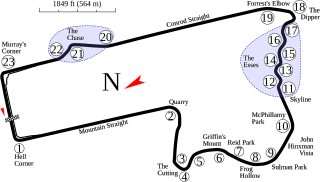
The 1988 Tooheys 1000 was a 1000 km endurance motor race for Group A Touring Cars. It was held on 2 October 1988 at the Mount Panorama Circuit just outside Bathurst in New South Wales, Australia. The race was the opening round of the 1988 Asia-Pacific Touring Car Championship and was the 29th running of the Bathurst 1000.
Gibson Motorsport was an Australian motor racing team that competed in the Australian Touring Car Championship from 1985 until 2003, though the team had its roots in Gibson's "Road & Track" team which ran a series of Ford Falcon GTHOs in Series Production during the late 1960s and early 1970s. The name of the team was also the name of Fred Gibson's automotive business in Sydney. As Gibson was also a driver for the Ford Works Team, his team was sometimes a pseudo-works team when the Ford factory did not enter.
The 1988 Australian Touring Car Championship was a CAMS sanctioned motor racing title for drivers of Group 3A Touring Cars. It was the 29th running of the Australian Touring Car Championship. The championship began on 6 March at Calder Park Raceway and ended on 17 July at Oran Park Raceway after nine rounds.
The 1986 Australian Touring Car Championship was the 27th running of the Australian Touring Car Championship. It began on 2 March 1986 at Amaroo Park and ended on 13 July at Oran Park Raceway after ten rounds. This was the second ATCC to be run to the FIA's international Group A Touring Car Regulations.
George Fury is a retired Australian rally and racing car driver. For the majority of his career Fury was associated with Nissan, twice winning the Australian Rally Championship, and twice runner up in the Australian Touring Car Championship. Fury, a farmer living and working in the New South Wales country town of Talmalmo, was nicknamed "Farmer George" or "The Talmalmo Farmer".
The 1985 Australian Touring Car Championship was a CAMS sanctioned motor racing title for drivers of Touring Cars. It was the 26th running of the Australian Touring Car Championship and the first to be contested using regulations based on the FIA's International Group A regulations after having been run under CAMS home grown Group C rules between 1973 and 1984. The championship began on 10 February 1985 at Winton Motor Raceway and ended on 14 July at Oran Park Raceway after ten rounds.

The 1987 Castrol 500 was a race for Touring Cars complying with Appendix C of the National Competition Rules of the Confederation of Australian Motor Sport. The event was staged on 13 September 1987 over 129 laps of the 3.9 km Sandown circuit in Victoria, Australia, a total distance of 503 km.
Allan Moffat Racing was an Australian motor racing team owned by multiple-championship winning Canadian-Australian racing driver Allan Moffat. The team was highly successful, winning races on three continents including three Australian Touring Car Championships in 1976, 1977 and 1983, four Bathurst 500/1000s including a memorable 1–2 victory in 1977, and the 1987 Monza 500, which was the inaugural race of the World Touring Car Championship.
AMSCAR was a touring car series held in Australia between 1979 and 1997, based at Amaroo Park in Sydney.
LoGaMo Racing, also known as Tony Longhurst Racing, was an Australian motor racing team that competed in Australian touring car racing between 1988 and 1994. The team was initially a collaboration between Tony Longhurst and Frank Gardner, with Terry Morris later joining as a shareholder, with their three names combining to create the LoGaMo name. The team is best known for winning the 1988 Bathurst 1000 with Longhurst and Tomas Mezera.